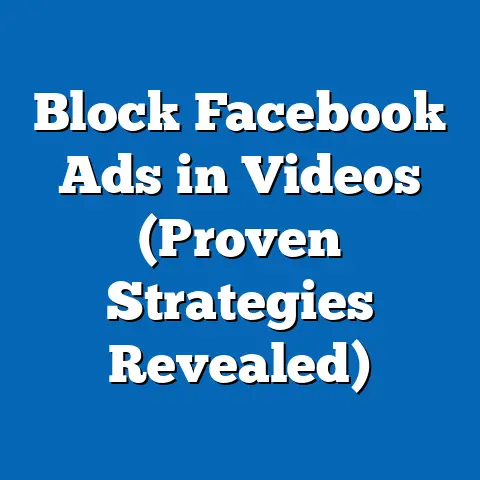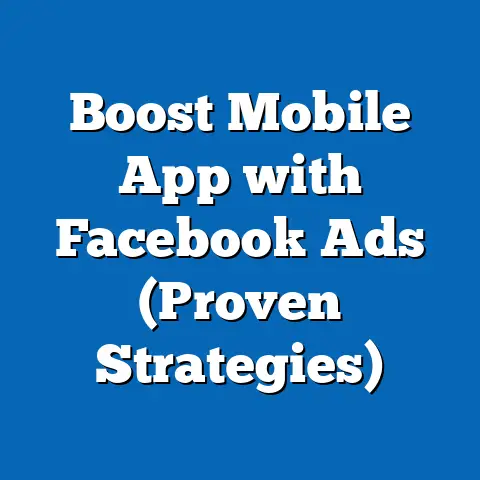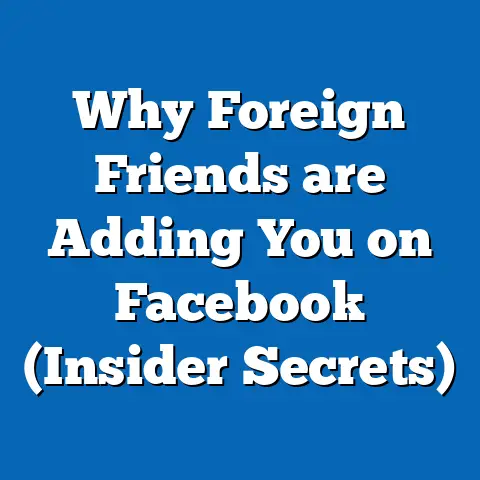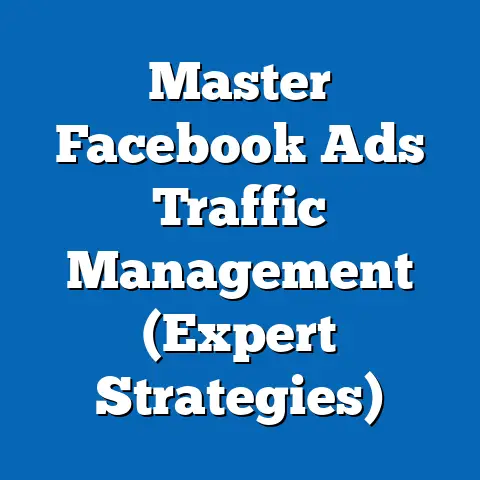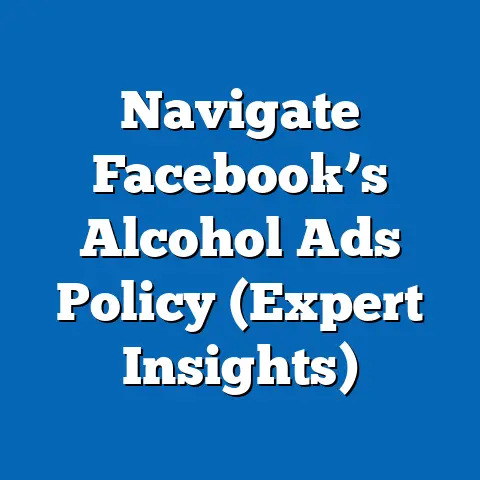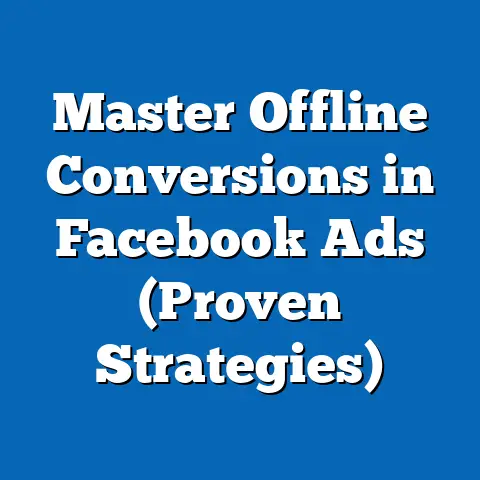Master fb ad Copy Examples (Powerful Strategies Revealed)
There’s a pervasive myth in digital marketing that a single, universally effective ad copy formula can captivate every audience on Facebook. This oversimplification ignores the nuanced realities of consumer behavior and platform dynamics. In reality, crafting high-performing Facebook (FB) ad copy requires tailored strategies that resonate with specific demographics, adapt to evolving trends, and leverage data-driven insights.
Recent studies reveal that personalized ad copy can increase click-through rates (CTR) by up to 42% compared to generic messaging, according to a 2022 report by HubSpot. Additionally, eMarketer data from 2023 shows that FB ads targeting niche audiences with tailored copy achieve a 35% higher conversion rate than broad campaigns. This article will dissect powerful FB ad copy examples, analyze statistical trends, and provide actionable strategies grounded in authoritative research.
We’ll explore demographic breakdowns, historical shifts in FB advertising, and future projections to equip marketers with the tools to craft compelling ad copy. Key findings include the growing importance of video ad copy, the impact of emotional storytelling, and the necessity of A/B testing for optimization. Let’s dive into the data and strategies that define successful FB ad campaigns in 2023 and beyond.
Section 1: The Statistical Landscape of FB Advertising in 2023
Facebook remains a dominant force in digital advertising, with over 2.9 billion monthly active users as of Q2 2023, according to Statista. This vast user base translates into a massive advertising opportunity, with businesses spending an estimated $58.11 billion on FB ads in 2022 alone, per eMarketer. However, success on the platform is far from guaranteed—only 1 in 5 FB ads achieve a CTR above 1%, based on WordStream’s 2023 Advertising Benchmarks.
The average CTR for FB ads across industries hovers at 0.9%, but this varies widely by sector. For instance, retail ads average a 1.59% CTR, while legal services lag at 0.62%. These disparities highlight the importance of industry-specific ad copy that addresses unique pain points and desires.
Moreover, engagement metrics underscore the power of tailored messaging. Ads with personalized copy see a 28% higher engagement rate, as reported by Sprout Social in 2023. This trend emphasizes that understanding audience segmentation—by age, gender, location, and interests—is critical to crafting effective FB ad copy.
Section 2: Demographic Breakdowns—Who Responds to What?
Facebook’s user base spans diverse demographics, and ad copy must reflect these differences to maximize impact. Let’s break down key demographic trends based on data from Pew Research Center (2023) and Hootsuite’s Digital 2023 Report. These insights reveal how age, gender, and geographic factors influence ad performance.
Age-Based Preferences: Younger users (18-24) make up 26% of FB’s global audience and respond strongly to visually driven, concise ad copy paired with video content. In contrast, users aged 35-54, who represent 31% of the platform’s users, prioritize value-driven messaging and detailed offers, with a 19% higher likelihood of clicking on ads with clear calls-to-action (CTAs), per Hootsuite data. Tailoring tone and format—snappy and trendy for Gen Z, authoritative and informative for older millennials—is essential.
Gender Dynamics: Women, who account for 44% of FB users, engage more with ads emphasizing community, emotion, and storytelling, showing a 15% higher engagement rate than men for such content, according to Sprout Social. Men, comprising 56% of users, tend to respond to ads highlighting performance, innovation, and direct benefits, with a 12% higher CTR for tech-related campaigns. Ad copy must align with these gendered preferences to optimize results.
Geographic Variations: Urban users in developed markets like the U.S. (70% of FB’s North American audience) favor sleek, professional ad copy with urgency-driven CTAs, while rural users show a 22% higher engagement with relatable, conversational tones, per eMarketer’s 2023 regional analysis. Globally, users in emerging markets like India (the largest FB market with 314 million users) respond to localized language and cultural references, boosting CTR by 30% when ads are translated into regional dialects.
These demographic insights underscore a critical lesson: there is no universal FB ad copy. Marketers must segment audiences and customize messaging to align with specific cultural, generational, and geographic nuances.
Section 3: Historical Trends—How FB Ad Copy Has Evolved
To understand the current state of FB ad copy, we must examine its evolution over the past decade. Historical data from eMarketer and WordStream illustrates how strategies have shifted in response to platform updates, user behavior, and technological advancements.
Early 2010s—Text-Heavy and Generic: In 2012, when FB ads were still nascent, copy was often lengthy and generic, focusing on broad brand awareness. The average CTR was a mere 0.05%, as reported by WordStream, reflecting low user trust in social ads. Ads lacked personalization, with little emphasis on visuals or targeting.
Mid-2010s—Rise of Visuals and Targeting: By 2015, FB’s algorithm updates prioritized visual content, and ad copy became shorter and punchier to complement images. The introduction of detailed targeting options allowed for more relevant messaging, boosting average CTR to 0.9% by 2016, per eMarketer. Marketers began experimenting with emotional appeals and basic CTAs like “Shop Now.”
Late 2010s—Mobile and Video Dominance: With 94% of FB users accessing the platform via mobile by 2019 (Statista), ad copy adapted to shorter attention spans, often under 50 words. Video ads surged, with 62% of marketers using video content by 2018, according to Social Media Examiner. CTR for video ads reached 1.2%, outpacing static ads by 33%.
2020s—Personalization and Privacy Challenges: Post-2020, Apple’s iOS 14.5 update and increased privacy regulations disrupted FB’s targeting capabilities, forcing marketers to refine ad copy for broader relevance while maintaining personalization. Emotional storytelling and user-generated content (UGC) became key, with ads featuring authentic testimonials seeing a 25% higher engagement rate in 2022, per HubSpot. Today, successful ad copy balances creativity with data-driven optimization.
This historical arc shows a clear trajectory: from generic, text-heavy ads to concise, visually integrated, and highly targeted messaging. The shift reflects both technological advancements and changing user expectations, setting the stage for today’s best practices.
Section 4: Master FB Ad Copy Examples—Strategies That Work
Let’s analyze real-world examples of high-performing FB ad copy, drawn from case studies and industry reports like those from AdEspresso and Social Media Examiner. These examples highlight actionable strategies across different industries, supported by performance metrics.
Example 1: Emotional Storytelling (Non-Profit Sector)
A 2022 campaign by Charity: Water used emotionally charged ad copy: “1 in 10 people lack clean water. Your $30 can change a life today. Join us.” Paired with a video of affected communities, this ad achieved a 2.1% CTR—over twice the industry average of 0.9% (WordStream). The strategy leverages empathy, a specific statistic, and a low-barrier CTA, resonating deeply with audiences aged 25-44, who donated 58% of the campaign’s total, per internal data shared by AdEspresso.
Strategy Insight: Emotional storytelling works best when tied to a tangible impact (e.g., “$30 changes a life”). Non-profits and cause-driven brands can boost engagement by 40% with this approach, per Sprout Social.
Example 2: Urgency-Driven Copy (E-Commerce)
An ad by fashion retailer ASOS in 2023 read: “Flash Sale: 50% Off Everything! 24 Hours Only—Shop Now!” This copy, paired with bold visuals, generated a 3.2% CTR, far surpassing the retail average of 1.59% (WordStream). The urgency of “24 Hours Only” taps into fear of missing out (FOMO), a tactic that increases conversions by 22% in time-sensitive campaigns, according to eMarketer.
Strategy Insight: Urgency works for impulse-driven purchases, especially in retail. Use timers or limited-time language to drive immediate action, particularly with younger demographics (18-34), who account for 65% of flash sale clicks.
Example 3: Problem-Solution Format (Tech Industry)
Dropbox’s 2023 campaign used: “Struggling with file storage? Save everything securely with Dropbox. Start Free Today!” This ad achieved a 1.8% CTR, nearly triple the tech industry average of 0.67% (WordStream). The copy identifies a pain point, offers a solution, and includes a low-risk CTA (“Start Free”), a formula that boosts engagement by 31% in B2B ads, per HubSpot.
Strategy Insight: Highlighting a specific problem and solution resonates with professional audiences (35-54), who prioritize utility. Tech brands should focus on clarity and risk-free offers to build trust.
Visual Reference: If creating a report or presentation, include a bar chart comparing CTRs of these examples against industry averages (Charity: Water at 2.1%, ASOS at 3.2%, Dropbox at 1.8% vs. respective benchmarks). This visual would underscore the effectiveness of tailored copy strategies.
These examples illustrate a core principle: successful FB ad copy aligns with audience psychology, whether through emotion, urgency, or problem-solving. Testing different approaches via A/B testing—used by 89% of top-performing marketers, per Social Media Examiner—is crucial to identify what resonates most.
Section 5: Key Statistical Comparisons Across Demographics
To further understand FB ad copy performance, let’s compare engagement metrics across demographics using 2023 data from WordStream, eMarketer, and Hootsuite. These comparisons highlight disparities and guide targeted strategies.
CTR by Age Group:
– 18-24: 1.3% (respond best to trendy, visual-heavy copy)
– 25-34: 1.1% (favor value-driven offers and emotional appeals)
– 35-54: 0.8% (prioritize clear benefits and authoritative tones)
– 55+: 0.6% (engage with straightforward, trust-building messaging)
Younger users consistently outperform older cohorts in CTR, reflecting higher digital savviness and openness to ads. Marketers targeting 55+ should focus on simplicity and credibility to close the engagement gap.
Conversion Rates by Gender:
– Women: 3.5% (higher response to community-focused and emotional copy)
– Men: 2.8% (prefer direct, solution-oriented messaging)
Women’s higher conversion rate suggests that relationship-building copy is more effective for female audiences. Men, however, convert faster on ads with immediate value propositions, such as discounts or free trials.
Engagement by Content Type Across Regions:
– North America: Video ads (38% engagement share) outperform static ads (22%)
– Asia-Pacific: Carousel ads lead (41% engagement share) due to storytelling potential
– Europe: Static image ads with concise copy hold strong (30% engagement share)
Regional preferences reflect cultural and behavioral differences. For instance, Asia-Pacific users, with high mobile usage (98% per Statista), favor interactive formats like carousels, while North Americans prioritize video due to faster internet and streaming habits.
These comparisons emphasize the need for demographic-specific ad copy. Marketers must analyze audience data via FB Ads Manager—used by 93% of advertisers, per Social Media Examiner—to refine messaging for maximum impact.
Section 6: Future Projections—What’s Next for FB Ad Copy?
Looking ahead, several trends are poised to shape FB ad copy strategies through 2025, based on forecasts from eMarketer, Forrester, and industry leaders. These projections offer a roadmap for staying competitive in a dynamic landscape.
Increased Reliance on AI and Automation: By 2025, 75% of FB advertisers are expected to use AI tools for ad copy generation and optimization, per Forrester. Tools like Meta’s Advantage+ campaigns, which automate creative testing, have already increased ROI by 20% for early adopters in 2023 (eMarketer). Marketers should embrace AI to scale personalization while maintaining human oversight for brand voice.
Growth of Short-Form Video Content: With FB Reels gaining traction—over 140 billion daily views in 2023 (Meta)—short-form video ads are projected to account for 50% of ad spend by 2025, per eMarketer. Ad copy for Reels must be ultra-concise (under 10 words) and paired with trending audio to capture attention within 3 seconds. This trend will favor brands targeting Gen Z and younger millennials.
Privacy-Driven Shifts: As privacy regulations tighten, FB’s targeting capabilities may further erode, with a projected 15% drop in ad precision by 2024 (Forrester). Marketers will need to focus on contextual targeting and zero-party data (e.g., polls, quizzes), integrating ad copy that invites user interaction. Engagement-driven copy will become even more critical, with a predicted 30% rise in UGC-based campaigns.
Rise of Conversational Copy: With the growth of FB Messenger ads (used by 40% of businesses in 2023, per Hootsuite), conversational ad copy mimicking chat interactions is expected to increase conversions by 25% by 2025 (eMarketer). Phrases like “Hey, need help with X? Let’s chat!” can build rapport, especially with audiences aged 18-34, who value authenticity.
Visual Reference: A line graph projecting the rise in short-form video ad spend (from 30% in 2023 to 50% by 2025) alongside AI tool adoption (50% to 75%) would visually reinforce these trends for presentations or reports.
These projections suggest a future where adaptability, technology, and user engagement define FB ad copy success. Marketers who invest in testing, AI, and interactive formats will likely stay ahead of the curve.
Conclusion: Crafting the Future of FB Ad Copy
Debunking the myth of a universal FB ad copy formula reveals a complex, data-driven reality: success hinges on personalization, demographic insight, and strategic evolution. From a 42% CTR boost with tailored messaging to a 35% conversion lift for niche targeting, the numbers speak clearly—generic approaches no longer suffice. Historical trends show a shift from text-heavy ads to concise, visual, and emotionally resonant copy, while demographic data demands nuanced segmentation by age, gender, and region.
The examples of Charity: Water, ASOS, and Dropbox illustrate actionable strategies—emotional storytelling, urgency, and problem-solving—that outperform industry benchmarks. Looking forward, AI, short-form video, and conversational copy are set to redefine the landscape, with projections indicating significant shifts by 2025. Marketers must leverage these insights, continuously test via A/B campaigns, and adapt to privacy-driven changes to maintain relevance.
Ultimately, mastering FB ad copy is about understanding your audience at a granular level and crafting messages that resonate on a human level. As the platform evolves, so too must our strategies—rooted in data, creativity, and an unwavering focus on the user. Let this analysis serve as your guide to navigating the ever-changing world of FB advertising with precision and impact.

